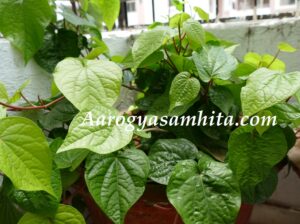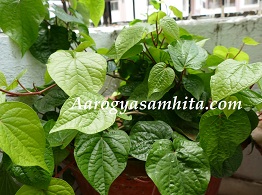Welcome to the betel leaf post! Here, you will find all the information and advice you need to know about betel leaf, its benefits, and how to properly use it. Betel leaf, or Piper betle, is a vine-like evergreen shrub native to tropical Asia. It has been used medicinally and as a condiment for centuries, and is still an important part of many cultures in the region. The leaves are chewed to release their juices, often paired with areca nut, as part of a ritual. The leaves of Betel leaf are highly nutritious and have a plethora of health benefits. These include the potential to reduce inflammation, improve digestive health, and even improve heart health. In addition, Betel Leaf has been known to possess antifungal, antiviral, and antimicrobial properties.
Betel Leaf Nutrition Facts and Calories Chart
Betel leaves are an excellent source of vitamin A, vitamin C, dietary fiber, and some essential minerals. They contain many essential nutrients such as thiamine, riboflavin, niacin, folate, phosphorus, calcium, potassium, magnesium, iron, zinc, and copper. Betel leaves are also rich in antioxidants, which help neutralize free radicals and protect against cell damage. In addition, betel leaves are a good source of fiber, which helps promote healthy digestion and can help reduce cholesterol levels. Nutritional value per 100 g betel leaves:
- Biotin: 0.33 μg
- Calcium: 150 mg
- Carbohydrates (Carbs): 11.9 g
- Chloride: 44 mg
- Cholesterol: 0 mg
- Choline: 9.7 mg
- Chromium: 0.2 μg
- Copper: 0.2 mg
- Dietary Fiber: 0.9 g
- Energy (Calories): 24 kcal
- Fat: 0.5 g
- Iodine: 0 μg
- Iron: 0.7 mg
- Magnesium: 28 mg
- Manganese: 0.1 mg
- Molybdenum: 0.2 μg
- Pantothenic Acid: 0.3 mg
- Phosphorus: 27 mg
- Potassium: 190 mg
- Protein: 1.2 g
- Saturated fat: 0.1 g
- Selenium: 0.3 μg
- Sodium: 21 mg
- Sugars: 0.3 g
- Vitamin A: 4 μg
- Vitamin B1 (Thiamin): 0.02 mg
- Vitamin B2 (Riboflavin): 0.03 mg
- Vitamin B3 (Niacin): 0.2 mg
- Vitamin B5 (Pantothenic Acid): 0.3 mg
- Vitamin B6: 0.08 mg
- Vitamin B9 (Folate / Folic Acid): 7 μg
- Vitamin B12: 0 μg
- Vitamin C: 0 mg
- Vitamin D: 0 μg
- Vitamin E: 0.1 mg
- Vitamin K: 10 μg
- Water: 83.2 g
- Zinc: 0.2 mg
When it comes to cooking with betel leaf, there are a number of ways to do so. The leaves can be boiled, steamed, or fried. They can also be added to salads, soups, and curries to add flavor and texture. We hope this blog serves as a helpful resource for all your Betel Leaf needs. Whether you’re looking to learn more about the benefits of Betel Leaf, or you’re looking for recipes and advice on how to cook with it, we’ve got you covered. Thank you for visiting and happy cooking!
Betel Leaves In India
- Scientific Binomial: Piper betle Linn. / Folium Piperis betlis
- Common English: Betel pepper / Buyo Leaves Ikmo Leaves / Betelvine
- Ayurvedic: Taambula, Naagvallari, Naagini, Taambulvalli, Saptashiraa, Bhujangalataa
- Unani: Paan
- Sanskrit: Tambool
- Hindi / Urdu: Pan ka Patta / gillauri / Beeda
- Bengali
- Marathi: Nagarvel / Naginiche Pan
- Telugu: Killi and Tambulum / Tamalapaku
- Tamil: Vetrilai Nagavalli or Kammaaruvetritai / Vethalai
- Gujarati
- Kannada: Veelya or Taamboola or Yele Adike
- Malayalam: Vetrrilai / Thambulam
- Oriya
- Punjabi / Sindhi
- Assamese
- Kashmiri
- Konkani
- Manipuri
- Dogri
- Bhojpuri
- Mandarin Chinese: JuJiang Ye, Qing Lou Ye
- Cantonese: Geui Jeung Yip

Health Benefits and Side Effects
History of Quid
Throughout India, it is customary to offer a paan leaf quid (beeda) at the end of the meal as a breath freshener and an aid to digestion. The paan leaf is filled with a mixture of bitter, sweet, and sour flavors, such as: kattha, chuna (lime), betel nut, coconut, cardamom, aniseed, sugar balls, and melon seeds. Then secure the leaf with a clove. Apart for eating these leaves are also used for dyeing purpose. Gambir is prepared by boiling the leaves and evaporating the decoction until it acquires the consistence of clay. This gambir is useful for tanning leather, also by dyers and curers, forming an article of export.
Health Benefits
Betel leaves chewed with certain fruits and cardamom aid in clarity and keep the mouth fresh. “Chavicol” present in betel leaf give spicy taste to the leaf and helps in expelling worms. Natural oil present in the leaf helps to improve appetite and also helps fighting tooth decay. Here are few popular betel leaves health benefits.
- Baby Colic: Most of the babies cry during evening time due to stomach bloating. For this betel leaf is very useful. Firstly take a fresh leaf on the soft side of leaf, apply few drops of castor oil. spread it evenly. Then keep it on baby’s stomach. On top of this leaf try holding a warm cloth gently. This is helpful in expelling the gas and makes baby feel comfortable.
- Digestion Aid: Eating fresh betel leaf quid after heavy meal is helpful digestion. It helps to increase saliva secretion which is helpful for digestion.
- Calcium Supplement: Betel leaf and lime is perfect combination to get enough amount of calcium for body. Early morning, at empty stomach, eat one betel leaf with chuna (lime) and eat. Repeat for 5 days. But be careful apply very little chuna on paan as direct contact of lime and tongue can hurt the tongue. This is very helpful in case of joint pains.
- Cough and Cold: Simply eating 2-3 plain tender leaves can help in cold. Try eating 1 plain leaf with few ajwain seeds and drink warm water after it. This will help to release the cough. In case of cough and cold, simply boil 15 leaves of betel in a glass of water and sip after intervals for better results.
- Healing: Take ripe custard apple fruit. Make a paste with betel leaves and then apply to tumor to hasten suppuration. In case of headache apply paste of nagarvel leaves on forehead. For minor burns apply paste of betel leaf.
- Sore Throat: Betel leaves have proved beneficial in the treatment of sore throat. Apply leaves locally for relief. Mix the fruit of the betel tree with honey and take it to relieve irritating throat cough.
- Skin Care – Carbuncles: Piper betle remedy is very effective for carbuncles. Take one betel leaf slowly heat on flame to make it smooth. Put some castor seed oil on it and wrap it around the boil. After 2-3 hours take out first leaf and apply second leaf in a same way. It will start working within few hours.
- General Tonic: Wrap 4 to 5 stigmas of saffron in a tender leaf of Piper betle. Then chew the leaf. Repeat this every day throughout the winter.
- Hair Growth: Betel leaf, hibiscus leaves and curry leaves makes very useful oil to promote hair regrowth. Just boil these leaves in coconut oil and strain the oil. Use these oil once a week on scalp, keep it for 12 hours and wash.
- Eye Health: Putting 2-3 drops of paan leaf juice extract helps to improve eye sight. This is also the best remedy for night blindness.
Side Effects
Apart from health benefits, betel leaves also has few side effects. Habitual consumption of paan quid containing tobacco shows a strong cytotoxic potential. The consumption of pan, bettle nut, tobacco and slaked lime has link with lung and throat cancers. Chewing pan and tobacco and smoking are other causes of bad breath.


Betel Leaf with Kasthuri Korosanai has proved to be an instant cure for fever in my childhood. I am following up this remedy for immediate relief from cold and fever till date.Whenever I go to India & I buy a couple of capsules or in pellet form.These can be bought from East Masi Street opposite to Thermutti (Rethu Bhundho) With this excellent medication of Kasthuri Korosanai enclosed in a Betel Leaf has been a proven instant treatment for severe cold & fever during rainy season.